 |
Stateside Service: The 89th Light Division

Again, a train rides through lovely country but it was back to Camp Roberts for me. We detrained, had our short-arm inspection, and were placed in empty barracks until all those arriving for the 89th Division could be collected and trucked up to the Hunter-Liggett Military Reservation in the nearby rugged coastal mountains near Salinas which, among other things, was known as the location of Randolph Hearst's fabulous mansion hideout. We grumbled when we saw army barracks again but we didn't realized that in just a few days we would be wishing we had them.
The 89th was still on maneuvers with another light division, the 71st, up in these rugged mountains. Let me explain what a light division was supposed to be. A regular, triangular, heavy infantry division is composed of approximately 15,000 men including three infantry regiments, an artillery brigade, and assorted combat and service units such as engineers, medics, etc. About a year before, the Army undertook an experiment with light divisions. Foremost, they would be reduced in size to 9,000 men (that's when a lot of 89ers had previously been transferred out to other divisions preparing for overseas movement) and would use much lighter weaponry and equipment, e.g., jeeps or mules as the prime movers for pack artillery and equipment. The 89th used jeeps and the 71st used mules as prime movers for weapons and supplies, augmented by human power in both cases, and the maneuver was to test the efficacy of one versus the other. In the end, it was concluded that light divisions in general were feasible only in very special and limited conditions. The10th Mountain Division was the only light division in the experiment to be retained and was soon sent to Italy. This meant that approximately 6,000 soldiers would have to be transferred into each of the two reorganized heavy divisions to bring them up to strength. These transfers into the 89th, including we ASTPers from OSC, began at Camp Roberts and Hunter-Liggett and continued when we arrived at Camp Butner as described below.
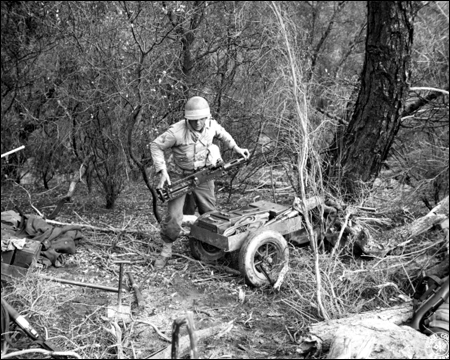 |
|
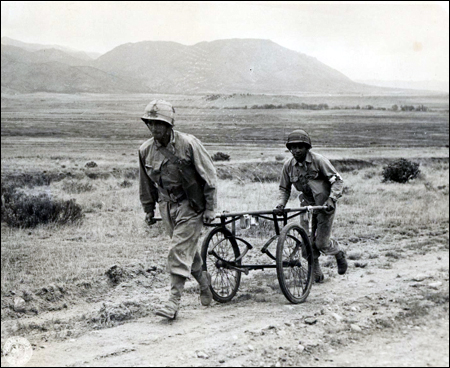 |
|
We did not realize it at the time, but this new and sometime jolting new assignment for most of us former ASTPers and Air Cadets was really a break of immeasurable proportions because it delayed our departure for combat by six months while we were expanded, re-equipped and trained. Most other ASTPers and Air Cadets were sent as replacements directly to infantry divisions ready to be deployed. One of my brothers-in-law had this experience and was wounded twice in France and Germany. My best friend in college and long after was sent to the 106th Infantry and became a machine gunner. This was the green division spread thin on the 100-mile front directly facing where the Germans broke through at the beginning of the Battle of the Bulge. He was wounded, captured and remained in a prison camp until the end of the war and suffered from trench foot for the rest of his life. In retrospect, while we had our losses, it was a lucky break for most of us who survived the war.
Within a couple of days, we were assembled, loaded on 2X4 trucks and began the trek up to the mountains. I can remember the scene vividly. In a large, reasonably flat field, 2x4 trucks were arranged in a large circle with their fronts facing outward. On the tailgate of each truck, arranged in a large circle, were one or more officers and non-coms representing each Infantry Regiment, Artillery Battalion and other major units. We were all dumped in the middle of the field and then, in order, each officer read out the names and serial numbers of the soldiers assigned to his unit(s) and those selected were assembled and trucked to where the units were bivouacked.
Each time the "Ks" were reached by an infantry officer, I would hold my breath in hopes that I didn't hear my name. The opposite was true when artillery selections were made. Gradually, the number of us waiting the call was diminished. Finally, they were done but there still were a fairly large number of us left. Some how or other, I missed (or they missed) my name and on rechecking the list, it was ascertained that I had been assigned to the 340th Field Artillery Battalion. As a form tank destroyer gunner, this made sense and I was much relived.
Off we went to the 340th bivouac area further up the mountains where I was assigned to Battery B. Old timers were housed in pyramidal tents, which held approximately 6 to12 soldiers, but there were none left for the new arrivals. We were issued pup tents (two shelter halves are combined to make a low, two-man tent) with some straw for bedding. Army life was changing back to normal about as fast and as brutal as possible. As the exercises with the 71st continued, probably just to keep us all busy before we could be shipped out, we got a little taste of what warfare in the mountains could be like, such as that experienced by our troops in Southern Italy. It was tough but as I recall there was no more than the usual bitching and, we took the fortunes of war in good stride and buckled down to prepare ourselves for what lay ahead. In an interview which the Battery Commander, Capt Lightbaum had with each new arrival, I expressed my desire to be a gunner again which seemed to meet with his approval. Soon, I was backing up one of the gunners and was happy with the prospect of being assigned as a gunner when the battery was eventually expanded and equipped with 105mm guns.
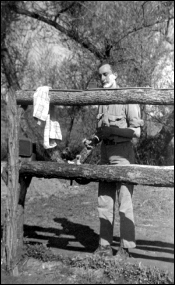 | |  | |  |
Shave | | Ed Roberts | | Up We Go! |
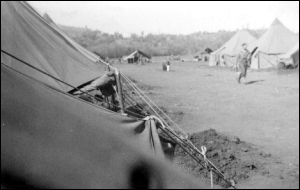 | | 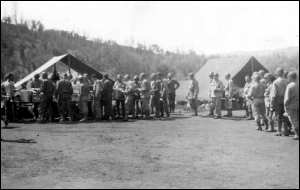 |
Battery Street | | Chow Line |
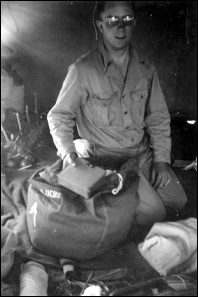 | | 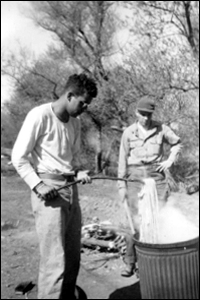 |
Barrack Bag Blues | | Wash Day |
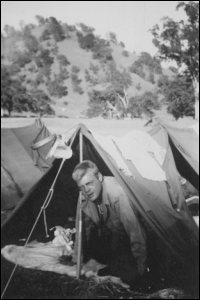 | | 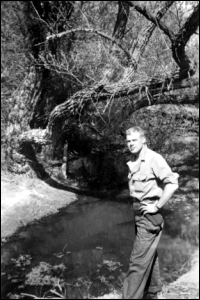 |
Home | | Free Running Water |
<< Oregon State College/ASTP |
Camp Butner >>
|
 |












